Megami Tensei, marketed internationally as Shin Megami Tensei, is a Japanese media franchise created by Aya Nishitani, Kouji "Cozy" Okada, Ginichiro Suzuki, and Kazunari Suzuki. Primarily developed and published by Atlus, and currently owned by Atlus, the franchise consists of multiple subseries and covers multiple role-playing genres including tactical role-playing, action role-playing, and massively multiplayer online role-playing. The first two titles in the series were published by Namco, but have been almost always published by Atlus in Japan and North America since the release of Shin Megami Tensei. For Europe, Atlus publishes the games through third-party companies.

Jack Bros. is an action video game developed and published by Atlus for the Virtual Boy, released in late 1995 in Japan and North America. It is a spin-off from Atlus' video game series Megami Tensei, and was the first entry to be released outside Japan.

Devil Summoner: Soul Hackers is a 1997 role-playing video game developed by Atlus. The game is the second installment in the Devil Summoner series, itself a part of the larger Megami Tensei franchise. Originally published by Atlus for the Sega Saturn, it was later ported to the PlayStation in 1999 and Nintendo 3DS in 2012.

Radiant Historia is a role-playing video game co-developed by Atlus and Headlock for the Nintendo DS. It was released in Japan in 2010 by Atlus, and in North America in 2011 by their subsidiary Atlus USA. An expanded remake for the Nintendo 3DS, titled Radiant Historia: Perfect Chronology, was released in 2017 in Japan and released in North America and Europe the following year, with the European version being published by Deep Silver.

Bravely Default, known in Japan as Bravely Default: Flying Fairy, is a role-playing video game developed by Silicon Studio for the Nintendo 3DS handheld console. Bravely Default was originally released in 2012 and later rereleased as an expanded edition in 2013 subtitled For the Sequel in Japan. For the Sequel was later released in Europe, Australia, and North America in 2014 simply titled as Bravely Default. This expanded edition used the subtitle Where The Fairy Flies in territories outside of Japan. Square Enix published the game in Japan, while Nintendo handled publishing duties overseas. The gameplay uses a turn-based battle system and job system, in addition to incorporating options to combine job abilities and adjust battle speed and random encounter rates.

Persona 4 Arena is a fighting video game co-developed by P-Studio and Arc System Works and published by Atlus for arcades, PlayStation 3, and Xbox 360; the game is a spin-off from the Persona series, itself part of the larger Megami Tensei franchise. The game was published by Atlus in Japan and North America in 2012, and by Zen United in Europe in 2013. Gameplay follows standard fighting game conventions, with matches between two characters with individual movesets, and special expendable abilities. The storyline is told through visual novel segments.
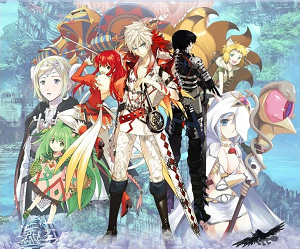
Unchained Blades, titled UnchainBlades ReXX in Japan, is a 2011 dungeon crawler role-playing video game developed by FuRyu and published by Xseed Games for the Nintendo 3DS and PlayStation Portable.
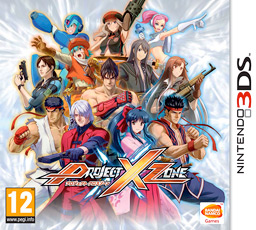
Project X Zone is a crossover tactical role-playing video game for the Nintendo 3DS developed by Monolith Soft with assistance from Capcom and Red Entertainment and published by Namco Bandai Games. It is a follow-up to Namco × Capcom and features characters from Namco Bandai, Capcom, and Sega. The game was released on October 11, 2012 in Japan; June 25, 2013 in North America; and July 5, 2013 in Europe. Project X Zone received mixed to positive reviews upon release; praise went towards the game's cast, combat system, and presentation, but criticism was directed at its repetitive gameplay and confusing storyline.
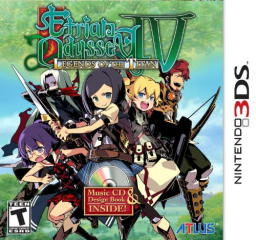
Etrian Odyssey IV: Legends of the Titan is a dungeon crawler role playing video game developed and published by Atlus for the Nintendo 3DS. It is the sequel to Etrian Odyssey III: The Drowned City and the first in the Etrian Odyssey series to be released on the Nintendo 3DS.

Tokyo Mirage Sessions ♯FE is a 2015 role-playing video game developed by Atlus and published by Nintendo for the Wii U home console. The game is a crossover that combines gameplay, narrative, and aesthetic elements from Atlus's Shin Megami Tensei and Nintendo's Fire Emblem series. It was released in Japan in December 2015 and worldwide in June 2016. An enhanced port for the Nintendo Switch, Tokyo Mirage Sessions ♯FE Encore, was released on January 17, 2020.
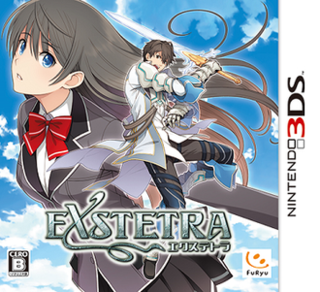
Exstetra is a Japanese role-playing video game developed by Studio Saizensen and published by FuRyu, developer of Unchained Blades and Last Bullet. It was released in Japan on November 7, 2013, for the Nintendo 3DS and PlayStation Vita. Due to the expiration of ClariS's music license, the game can no longer be purchased digitally on Nintendo 3DS since May 30, 2018.

Persona Q: Shadow of the Labyrinth is a role-playing video game developed by Atlus for the Nintendo 3DS. It is part of the Persona series, itself part of the larger Megami Tensei franchise. It was published across all territories in 2014: released in June in Japan, November in North America and Europe, and December in Australia. Atlus published the game in Japan and North America, while NIS America published it in the PAL region.

Bravely Second: End Layer is a role-playing video game developed by Silicon Studio for the Nintendo 3DS handheld console and is the direct sequel to Bravely Default. It was published by Square Enix in Japan on April 23, 2015, and by Nintendo in North America, Europe, and Australia in 2016.

Etrian Mystery Dungeon is a role-playing video game for the Nintendo 3DS. It was developed by Spike Chunsoft and Atlus, and published by Atlus in Japan on March 5, 2015 and Atlus USA in North America on April 7. It was published by NIS America in Europe on September 11. The game is a crossover between Atlus' Etrian Odyssey series and Spike Chunsoft's Mystery Dungeon series. A sequel, Etrian Mystery Dungeon 2, was released in Japan on August 31, 2017.

Etrian Odyssey is a dungeon crawler role-playing video game series. It is primarily developed and published by Atlus and currently owned by Sega. By 2016, the series had sold a combined total of 1.5 million copies worldwide.

The Caligula Effect is a role-playing video game developed by Aquria. It was released for the PlayStation Vita in Japan in June 2016, and by Atlus USA in North America and Europe in May 2017. A remake of the game, The Caligula Effect: Overdose, was released for the PlayStation 4 in Japan in May 2018, and worldwide by NIS America in March 2019 for the PlayStation 4, Nintendo Switch, and Windows. An anime adaptation of the same name premiered in April 2018.
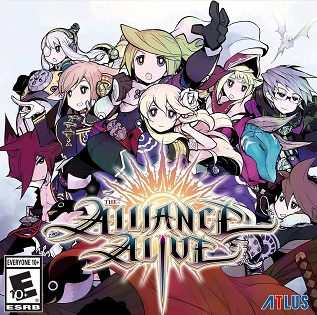
The Alliance Alive is a role-playing video game developed by Cattle Call for the Nintendo 3DS. The game was released in Japan by FuRyu in 2017, and was released worldwide by Atlus USA in 2018. The story follows a group of characters as they mount a rebellion against a race of Daemons that have ruled over humans since blotting out the sun a millennium before. Gameplay follows many traditions of the Japanese role-playing genre, including turn-based battles and navigation using a world map.
Cattle Call Inc. is a Japanese game developer based in Tokyo, Japan. The company was established by former staff of Data East Corporation and is engaged in developing original console games as well as co-developing and porting games for other game companies.

Luminous Arc is a series of tactical role-playing video games originally developed by Imageepoch, prior to the company's bankruptcy. The series began with the 2007 release of Luminous Arc for the Nintendo DS, with its most recent game being the 2015 Japan-only release of Luminous Arc Infinity. The series also saw a spiritual successor in the 2015 Nintendo 3DS game Stella Glow.


















